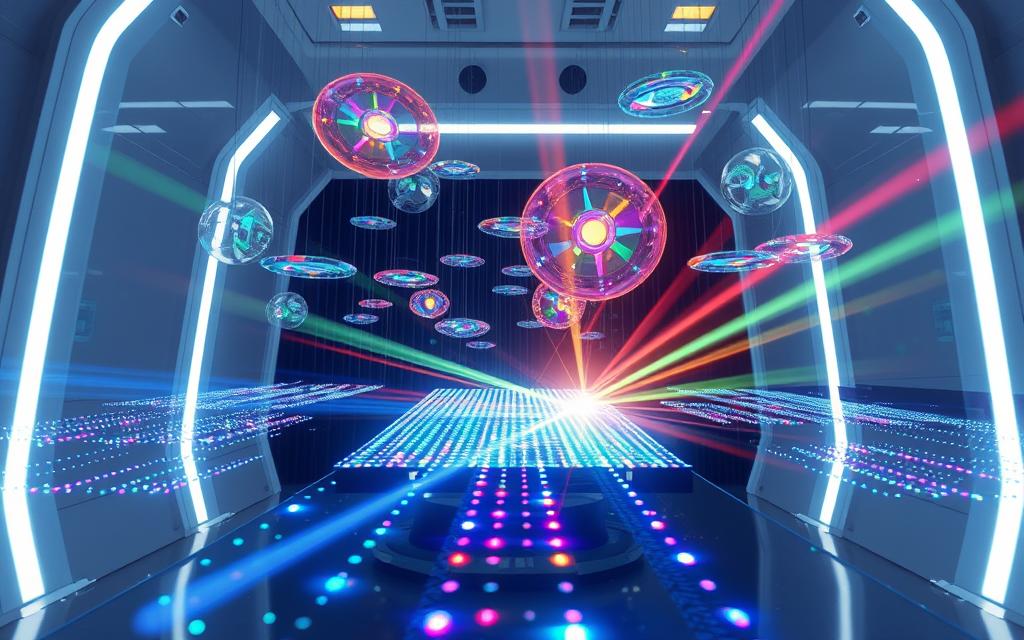Table of Contents
With digital information growing exponentially, new solutions are emerging to handle massive volumes. Experts predict global data creation will surpass 180 zettabytes by 2025. Traditional methods struggle with this demand, pushing innovators toward advanced storage technology.
Holographic systems store information in three dimensions, unlike surface-level discs. This approach boosts capacity dramatically—some prototypes achieve terabyte-per-square-inch density. Microsoft’s Project HSD, for example, uses crystalline materials and AI to enhance performance.
The concept dates back to the 1960s, but recent breakthroughs make it viable for modern needs. Unlike magnetic or optical media, these systems offer 50+ year longevity and parallel access speeds up to 1GB/s. As cloud and enterprise demands rise, this technology could redefine digital archiving.
Understanding Holographic Data Storage
Unlike flat storage, holographic technology captures information in 3D. This approach uses lasers to encode data within crystals or polymers, creating patterns that store terabytes in a tiny space. Early experiments in the 1960s laid the groundwork, but recent leaps make it viable today.
What Makes Holographic Storage Unique?
Traditional drives write data on surfaces. Holographic systems, however, use volume:
- 3D storage: Data stacks in layers, boosting capacity.
- Parallel access: Reads entire pages at once, speeding transfers.
- Longevity: Resists degradation for 50+ years.
The Evolution of Holographic Storage Technology
From labs to near-commercialization, the journey had highs and lows:
- 2000s: IBM and DARPA stored 1TB in lithium niobate crystals.
- 2006: InPhase’s 300GB prototype wowed CES but folded by 2010.
- 2009: GE’s photo-chromatic discs hit 500GB.
“Holographic storage’s potential is undeniable, but material costs stalled early adoption.”
Today, Microsoft leads with Project HSD, using AI to correct distortions. Meanwhile, Nintendo’s 2008 patent hints at gaming applications. The future? Faster, cheaper, and everywhere.
How Holographic Data Storage Works
At its core, this advanced method relies on light manipulation to store data in three dimensions. Unlike traditional drives, it captures information through intricate patterns, offering unmatched density and speed. The process involves lasers, crystals, and precise engineering to achieve remarkable results.

The Role of Lasers and Interference Patterns
Two beams—a signal and a reference—intersect within a photosensitive material. This creates an interference pattern, encoding information as holograms. The angle and wavelength determine how data stored is arranged, enabling multiple layers in the same space.
- Lithography: Patterns are etched using precise laser angles.
- Parallel processing: 1 million bits are written or read simultaneously.
- UV-blocking: Microsoft’s design prevents accidental erasure.
Key Components: From Signal Beams to Crystals
Crystalline materials like lithium niobate are pivotal. They react to light, preserving interference patterns long-term. Other essentials include:
- Signal beam: Carries the information to be recorded.
- Reference beam: Acts as a key to retrieve data later.
- Detector array: Captures reconstructed patterns during reading.
Reading and Writing in 3D Space
Accessing information requires replicating the original reference beam angle. A 0.2-second delay ensures minimal time loss. Challenges include:
- Angular precision: Even slight deviations corrupt retrieval.
- Crosstalk: Dense packing risks overlapping holograms.
- Durability: Crystals endure 10,000+ rewrite cycles.
“Zone-based designs, like Microsoft’s, optimize both capacity and reliability.”
Applications and Advantages of Holographic Storage
Industries handling massive archives are turning to 3D solutions for long-term preservation. This technology excels where traditional storage systems falter—offering unmatched density, speed, and durability. From legal documents to medical imaging, its impact spans critical sectors.
Revolutionizing Enterprise and Cloud Storage
Microsoft’s Azure explores petabyte-scale libraries using crystalline media racks. These cloud storage solutions could slash costs for data centers managing warm archives. Key advantages include:
- 50-year compliance: Meets WORM standards for legal and healthcare records.
- Energy efficiency: Uses 90% less power than tape libraries.
- Immutable logs: Ideal for GDPR audit trails in enterprise environments.
Cutting-Edge Use Cases
Apple’s 2018 acquisition of InPhase patents hints at AR content libraries. Other transformative applications:
- AI training: Accelerates retrieval for ML big data warehouses.
- Military vaults: EMP-resistant designs protect strategic records.
- Real-time analytics: Holographic SANs reduce latency for financial platforms.
“Crystalline media isn’t just about capacity—it’s about redefining reliability in the age of exponential data growth.”
Conclusion
Future-proof archives demand innovations beyond magnetic or optical limits. Holographic storage delivers both—1TB per square inch density and 50-year lifespans, outperforming HAMR drives. Yet precision manufacturing costs slow commercialization.
Hybrid systems blending NVMe speed with crystalline media may bridge gaps. Cloud providers like Microsoft Azure could drive adoption, leveraging technology for eco-friendly, high-capacity archives.
As long-term archival capabilities evolve, this approach may rewrite retention laws. The future of data preservation is volumetric, durable, and inevitable.
FAQ
What makes holographic storage different from traditional methods?
Unlike conventional hard drives or optical discs, this technology stores information in three dimensions. It uses light interference patterns inside crystals, allowing much higher capacity and faster retrieval.
How do lasers contribute to this technology?
Lasers split into two beams—a reference and a signal beam. Their interference creates a 3D pattern in photosensitive material, encoding multiple layers of data in the same physical space.
What materials are used for recording holograms?
Photorefractive crystals like lithium niobate or specialized polymers serve as the recording medium. These materials change their optical properties when exposed to laser light patterns.
Can existing systems read holographically stored information?
No, specialized readers are required. They reconstruct the original interference pattern by shining the reference beam through the crystal, which then diffracts to reveal the stored data.
What industries could benefit most from this advancement?
Medical imaging, scientific research, and media archives stand to gain significantly. The technology’s high-density capabilities make it ideal for long-term preservation of large datasets.
When did development of this approach begin?
Research started in the 1960s, but recent breakthroughs in laser precision and material science have accelerated practical applications. Modern systems now demonstrate commercial viability.









